I'm working with a battery-powered sensor that allows reading its measurements using two digital signals - a clock and a data line. The clock speed is abount 3kHz. In addition to those two signals, only battery ground and regulated 1.5V are accessible, and the two signals range between them, idling at 1.5V between measurements.
I'm trying to build a circuit to read measurements from multiple sensors of this kind. However, the sensor's case is electrically connected to its battery ground, and measurements are made by mechanically touching objects that might be at different electrical potentials relative to the ground of the circuit I'm trying to build. Because of this I want to avoid tying any of the sensor's battery grounds to ground in my circuit in order to not short ground to whatever potential the object I'm measuring is at.
I thought I'd use an optocoupler to isolate the sensor from the rest if the circuit, but unfortunately the current requirement of typical optocouplers is too large to be practical for the CR3202 battery-powered sensors I'm using, as it'd drastically reduce battery life. There do seem to be a number of specialised low-current optoisolators available, but their input voltage requirements seem to be higher than what I have available on the sensor side.
Is there a convenient way to achieve isolation between the sensor signals and the rest of my circuit using common components that doesn't require additional isolated power supplies for the sensors, and that would keep the additional current consumption from the sensor battery below, say, ~20uA?
Below is a pseudo-schematic trying to illustrate the problem I'm trying to address by isolating the sensors.
